Arts & Entertainment
Arts & Entertainment
A Desire for Art (4/26-5/3) (2)
- Details
- Published: 04 May 2013 04 May 2013
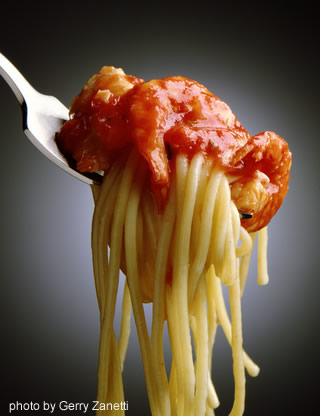 As a writer with an artist’s bent, I know what it is to have a desire for art. For me, it brings together the sum total of my being. Sometimes it’s about skewing ordinary reality into another vision; sometimes it’s about capturing a great moment in time; as a writer it’s about sculpting an idea into a completed form, with all of the pieces working together to resonate with truth.
As a writer with an artist’s bent, I know what it is to have a desire for art. For me, it brings together the sum total of my being. Sometimes it’s about skewing ordinary reality into another vision; sometimes it’s about capturing a great moment in time; as a writer it’s about sculpting an idea into a completed form, with all of the pieces working together to resonate with truth.
Not only does art satisfy my desire for self-expression, it fulfills my need to bring order upon experience. Art allows me to take that leap of the imagination and arrive at some place in an unpredictable universe, knowing that regardless, I will be safe.
For each of us who create art, the process is a very personal one, triggered by any number of impulses. The more artists that you talk to, the more you realize there is no right or wrong way to do it. What is the reference point from which your world view begins to expand and becomes a work of art in the making?
This weekend I went to the Greenwood Lake Library’s Art Extravaganza, which brought together eight artists, whose work had been on display previously as solo exhibits at the library. Pat Foxx, who has exhibited and taught for many years in the area, was the first artist I spoke to. She shared with me her current work: a series of acrylics that depict dreamy landscapes that are on display at the Seligmann Center for the Arts with a reception on Sunday, 5/5, from 2 - 5 p.m. Pat’s also a seasoned art instructor, watercolorist, and works at Fine Architectural Metalsmiths. I enjoyed viewing her portfolio of earlier work, when she was a professional fabric artist for 17 years. For Pat she says, "Looking within has become more important than representing the outside world. My work has become more abstract over time. But my love for nature prevails."
Arthur Patrick Gilmore is a fine watercolorist who has refined his art over many years. Traces of his earlier education, with an emphasis on abstract expressionism, can be found in his current art, an exhibition focused on the street life of NYC. His paintings center around people mingling and moving, capturing NYC’s unique energy. Gilmore says that “Creating art is about staying in the here and now; it’s not about arriving at some destination in the future.”
{besps}weekinreview/desireforart{/besps}
Leila Noueihed’s work I found interesting in terms of blending her sense of expressionism with realism. An experimental artist (is not all art experimental) focused on creating landscapes, Leila is also a Renaissance woman, with a rich linguistic background, a medical degree and a love for music. Despite not having any training as an artist, her natural abilities have taken her far and speak to the idea that if you have something you want to express, express it, even if it is raw and untamed.
Gerry Zanetti’s fine photography stands alone in terms of his unique focus: Close-up shots of food. Very commercially viable, Gerry spent a career shooting food for a long list of clients. As someone who appreciates good close-ups, I marveled at Gerry’s photos and their attention to detail, use of lighting and the way in which he captured the essence of a wide variety of food. Looking at an entire body of work from his website, I am convinced that Gerry has mastered his art form.
Other artists whose work I viewed included , Mustafa Al-Rahaman, Melissa Reichert, and Danielle Barbour. With a couple of these artists it was interesting to note how travel inspires art, as in the paintings of Levistsky and the photography of Reichert. Barbour produces a wide range of art, following her many passions including writing, sculpting, painting, inventing and model building. Mustafa is autistic and his work seems to capture a very colorful interior world.
Art is a great way to give meaning to our lives. I know. After I complete my week in review, I feel refreshed, knowing that I took the time to process an experience and create a small work of art.
Art for its own sake fulfills a need in me that seems to calm a restless energy. Once that desire is satiated, I feel more complete.
Fine Architectural Metalsmiths and Center for the Metal Arts: Carrying on Traditions, Inspiring New Generations
- Details
- Published: 01 April 2013 01 April 2013
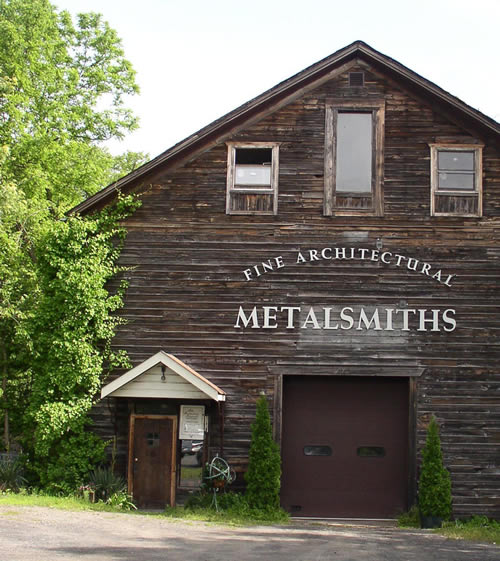
Over the winter, I went to Fine Architectural Metalsmiths (FAM) and their Center for the Metal Arts (CMA), to get a taste of the art of metalsmithing. Located in the village of Florida, NY, in a renovated icehouse from the 1890’s, it is one of those rare combinations of customized forge work, educational workshops and a gallery showcasing a large diversity of metal works.
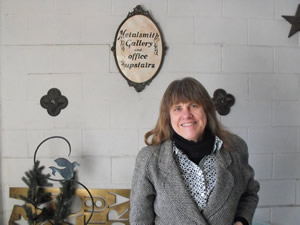 With the affable and very knowledgeable director Rhoda Mack to guide me along the way, I was introduced to what is also referred to as the “ice forge.” For an initiate like myself, there was a lot to take in, much more than an afternoon would allow. I started with a tour of their gallery, where you will find amazing artistic creations and art forms, railings and lighting fixtures, restoration projects, interior and exterior forged railings, formfolded metal, unique art pieces, metal tools, and designs and drawings that serve as the blue print for past and future projects.
With the affable and very knowledgeable director Rhoda Mack to guide me along the way, I was introduced to what is also referred to as the “ice forge.” For an initiate like myself, there was a lot to take in, much more than an afternoon would allow. I started with a tour of their gallery, where you will find amazing artistic creations and art forms, railings and lighting fixtures, restoration projects, interior and exterior forged railings, formfolded metal, unique art pieces, metal tools, and designs and drawings that serve as the blue print for past and future projects.
I was very impressed with several samples of work. One of them was a sharp-shinned hawk bronze casting, a highly realistic and interpretive piece. Full scaled, with careful detailing, it’s magnificent, both in the exact resemblance of a hawk and its equisite detail. I was also amazed by a collaborative project created in association with stained glass maker Sun Dog Studio. It was a curved metal shaped table inlaid with stained glass with a colored crane at the center, exemplifying fine craftsmanship and artistry. I secretly coveted a pair of bookends, shaped in perfect parellogram, with two figures on each side of the bookend pushing against it. I marveled at the precision, wondering how metal could be shaped so exact.
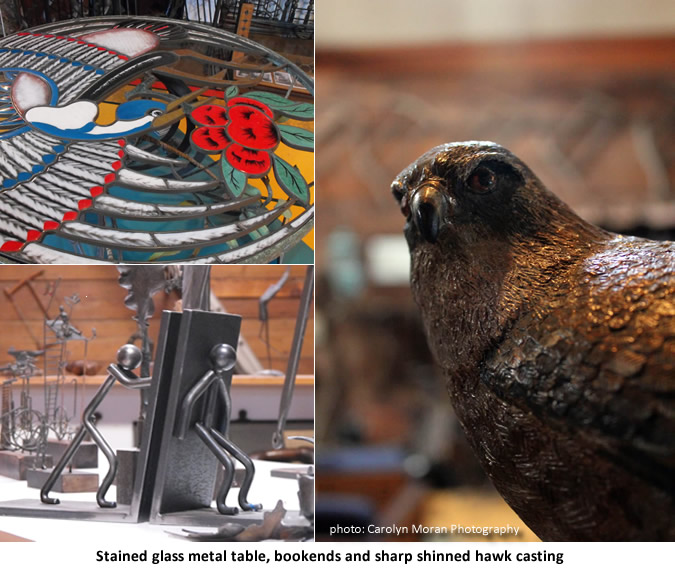
To see more works from their gallery, visit http://www.iceforge.com/Pages/Showroom.html.
Before leaving the gallery, a quote by Jaspar Johns caught my attention, expressing the nature of creating art. It began “Do something. Do something to that, and do something to that….Eventually the piece tells me it’s complete.” Art, be it metal or some other artistic avenue, happens in the doing. When asking Rhoda its significance, she stated “to challenge us onto the next possibility in a design and not to stop short. It’s easy to stop short and say I am done.”
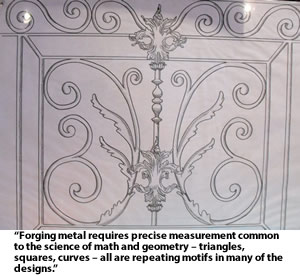 At the gallery, Rhoda pointed out the connection of the metal arts with other disciplines. “Geometry, metallurgy, art history, period styles, architecture, design, anthropology, fine arts - all cross over into this ancient art form.” Forging metal requires precise measurement common to the science of math and geometry – triangles, squares, curves – all are repeating motifs in many of the designs.
At the gallery, Rhoda pointed out the connection of the metal arts with other disciplines. “Geometry, metallurgy, art history, period styles, architecture, design, anthropology, fine arts - all cross over into this ancient art form.” Forging metal requires precise measurement common to the science of math and geometry – triangles, squares, curves – all are repeating motifs in many of the designs.
Metallurgy, which relates to the physical and chemical behavior of metal, is another important subject to master when practicing this craft. Knowing the difference between metals and how each responds to heat, for example, is the subject of metallurgy. Rhoda says, “Knowing that copper is more malleable than aluminum, which is brittle, is essential knowledge. Knowing how they respond to heat and under what conditions is also essential. You have to know these basics. You have to know what you can or cannot do.”
Since many of the samples in their gallery are restoration related, familiarity with art history and working within specific period styles, be it classical, renaissance, gothic, victorian, art deco, modern, etc., also informs a preference and methodology of working. A single major project that came out of FAM illustrates this point.
Several years back, FAM was commissioned to build a new courtyard gate based on the historic gate at the 72nd street entrance of the Dakota, which are private residences in NYC that consist of the famous apartments where John Lennon and Yoko Ono lived. The project brought together many of the facets of working in a rich, complex art form. According to Rhoda, “there were many changes replicating so many processes. Traditional forgework, mold making, chisel work, renaissance sheet work and classical blacksmithing all played a part. The exquisite forge scroll work presented a technical challenge.”
 FAM was established in 1981 by Rhoda’s husband, Ed Mack, for the purpose of carrying out custom forge work such as driveway and garden gates, railing and grilles, and signature lighting, in period and original styles. Their team of Metalsmiths have won numerous awards as a result of their fine craftmanship. In 2012, Mack was awarded the prized Julius Blum award for his outstanding contribution to the metal arts and fabrication industry. “Team effort is very important to Ed,” says Rhoda. “It’s always been very important for him to find what each person is good at and find ways to offer opportunities to do that. It gives him a lot of pleasure to see them doing something they love.”
FAM was established in 1981 by Rhoda’s husband, Ed Mack, for the purpose of carrying out custom forge work such as driveway and garden gates, railing and grilles, and signature lighting, in period and original styles. Their team of Metalsmiths have won numerous awards as a result of their fine craftmanship. In 2012, Mack was awarded the prized Julius Blum award for his outstanding contribution to the metal arts and fabrication industry. “Team effort is very important to Ed,” says Rhoda. “It’s always been very important for him to find what each person is good at and find ways to offer opportunities to do that. It gives him a lot of pleasure to see them doing something they love.”
Then in 2003 they opened the Center for the Metal Arts for the purpose of educating the public on blacksmithing, keeping the art alive by inviting guest speakers and master practitioners to conduct workshops and classes that provide hands on learning to people that want to learn about metal. Rhoda says, “If it’s not passed on, it dies. It’s not something to be learned from a book.” Ed’s interest in innovative technologies and design ideas and his love of freely sharing resources is at the core mission for this Center. Rhoda says, “This place has had to do with Ed’s vision and wide ranging interests where he was able to bring a lot of disciplines together.”
Since opening the Center, amongst some of the classes they have offered include blacksmithing, copper foldforming, creative pipe forging, forged tabletop sculpture and free form power hammer forging. I watched a workshop led by Jon Ledford, who taught a class on making animal faces from metal - from start to finish.
{besps}arts/art/metalarts/carolyn{/besps}
Photos by Carolyn Moran Photography
Jon has been working in this profession since his youth and apprenticed under his father for many years, before he struck out on his own. He now serves the facility through teaching at the Center and carrying out the various projects that are commissioned through FAM. One of Jon’s passions within the metal arts is tool making, as he showed me over a dozen tools that he has created to help other blacksmith’s in the process of working in the medium.
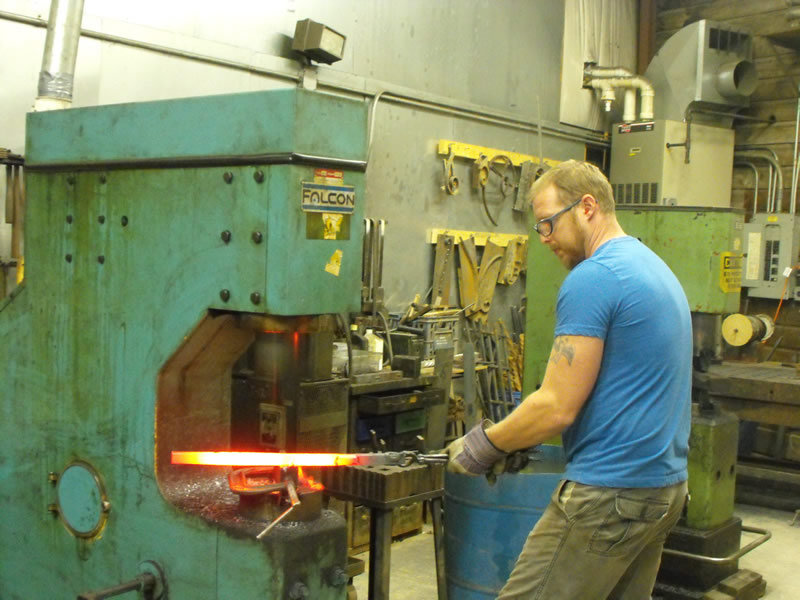
In addition to learning how to use the equipment is acquiring techniques in forging metal, which means to form the metal into a shape while it is hot enough to do so, hence the expression “strike the iron while it’s hot.” At Jon’s workshop, I saw some of the techniques involved in using tools to sculpt the faces, Jon giving instruction like: “You don’t want to go too deep with the center punch;” “You have to work quick;” “You have to round off the corners like this;” Acquiring a sense of timing is also important, as you will be multi-tasking when your “irons are in the fire.” Knowing when to take the irons out and when to put them back in and what to do with yourself in between is all a part of the process and part of the wisdom acquired along the way.

Every year the Center particularly looks forward to their big yearly event in August, when the highly acclaimed Charles Lewton-Brain comes to town to demonstrate and teach the art of foldforming, which is a “a synthesis of the Japanese art of origami with forging and other metalsmithing techniques.” The event is billed as an “idea fest for jewelers, sculptors, metal arts designers” as one learns how to fold various metals into shapes, employing a variety of techniques.
I had a wonderful afternoon discovering the achievements of FAM, learning about the Center and spending time with the people who play a role in shaping, teaching or learning about the metal arts. Later, entering their office, I viewed the display of awards and an eclectic collection of books that form their library. “Books have intrigued Ed from Impressionism, popup books to the classic metal arts techniques,” says Rhoda.

It all comes together here – where knowledge meets practice. For Rhoda and Ed Mack, it’s a fitting conclusion – much to be proud of, much to look forward to - preserving traditions and inspiring new generations to come.
Zooming in on the Greenwood Lake Airshow: Fine Photography by Gerry Molitor
- Details
- Published: 24 August 2012 24 August 2012
{besps}stories/photography/greenwoodlakeairshow{/besps}
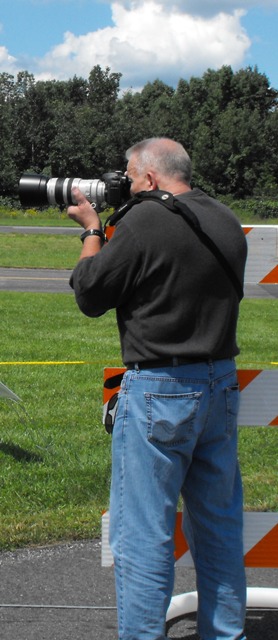 Gerry Molitor lives in Wyckoff, NJ and spends a lot of time in the Warwick Valley. He is a motorcycle guy, riding 12 months a year.
Gerry Molitor lives in Wyckoff, NJ and spends a lot of time in the Warwick Valley. He is a motorcycle guy, riding 12 months a year.
